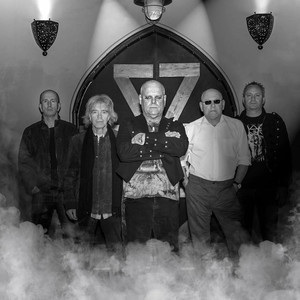
Witchfynde
英文名:Witchfynde
性别:组合
类别:
生日:
简介:by Ed RivadaviaEnglands Witchfynde was just one of many early-80s groups to be conveniently lumped into the New Wave of British Heavy Metal, but they were nowhere near as sonically extreme as their exaggeratedly Satanic image and references would suggest. In fact, despite displaying a wealth of heavy metal influences, their music was characterized by a strange duality, as prone to embracing downright dumb pub rock workouts, as it was to indulging in high-concept songwriting reminiscent of 70s progressive rock.Formed in Nottinghamshire England, Witchfyndes roots can be traced back as far as 1975, but it wasnt until late 1979 that vocalist Steve Bridges, guitarist Montalo, bassist Andro Coulton, and drummer Gra Scoresby achieved any manner of recognition with the release of their first single Give em Hell. Signing with Rondolet Records in early 1980, they quickly followed this with a proper album bearing the same name and a none-too-subtle cover artwork (boasting a goat-headed-devil-monster-thing) which, no doubt, gave future black metal pioneers Venom an idea or two. But the albums contents could hardly be called extreme, only bordering on heavy metal most of the time as the group flirted with prog-rock excess and punk rock simplicity in equal measures. It did, however, land them a coveted support slot on a tour across the U.K. that summer with fast-rising N.W.O.B.H.M. stars Def Leppard, after which Witchfynde quickly set about recording their second album of 1980 with new bassist Pete Surgey. Released just before the new year, the notably mainstream Stagefright toned down both the occult imagery and the more aggressive elements of the bands sound, confirming to most observers that Witchfyndes affiliation with heavy metal was tenuous at best. Indeed, hard-edged material was now clearly the exception to the rule, as the band delved liberally into very accessible radio rock and even (terribly ill-fated) attempts at the odd ballad or two. Needless to say, original fans were not impressed and stayed away in droves, prompting the band to once again turn up their faux-satanic showboating, even as their musical direction remained questionable and confusing. New vocalist Luther Beltz (initially choosing the ill-advised nom-de-guerre Chalky White) joined their tanks in early 1981, just in time to perform on the BBCs Friday Rock Show and watch the bands record company Rondolet go bankrupt. Various silly excuses were conjured up to explain the bands long absence in the next few years before they finally re-emerged in 1983, signed to new label Expulsion and released their third album Cloak and Dagger. Vocalist Beltz distinguished himself with his often grating King Diamond-esque falsetto, and the band certainly sounded tighter and more confident than ever; but everything else about their music and cabalistic image felt hopelessly dated by now. The album went nowhere and the musicians soon found themselves at yet another label (Mausoleum) with yet another new bassist (one Edd Wolfe) and yet another unsuccessful record, 1984s Lords of Sin. Once again, Witchfynde vanished from sight (thankfully, with no cockamamie excuses this time), but their inclusion in 1990s excellent N.W.O.B.H.M. 79 Revisited collection and a decent enough greatest hits set in 1996s The Best of Witchfynde ensured that their name was never entirely forgotten. Still, hardly anyone could have foreseen a reunion until it actually took place in 2001, leading to a slew of concert dates (including their first North American jaunt) and a new album called The Witching Hour featuring Montalo, Surgey and Scoresby alongside new vocalist Harry Harrison. Confusingly, former singer Luther Beltz, whod originally been involved with these reformation plans only to bow out at the last second, decided to put together his own competing version of Witchfynde, and is also threatening to tour and record — strange but true.
